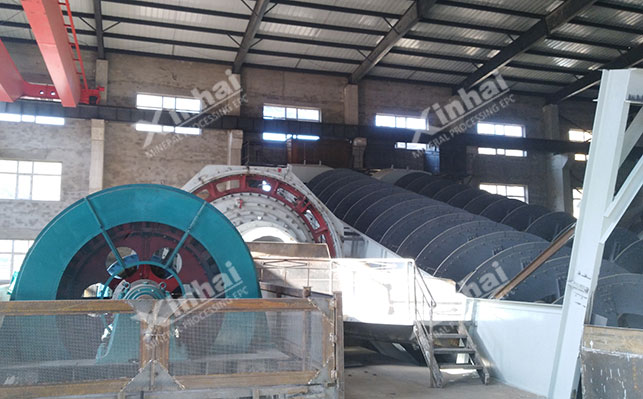
15311826613
Click to add WeChatWormite is mostly quartz large vein type or fine vein type tungsten deposit, which belongs to gasification high temperature hydrothermal type deposit. Wolframite is enriched in quartz in the form of coarse plate or fine vein crystals, with coarse embedded particle size, which is easy to separate. Wormite beneficiation generally adopts a combined beneficiation process mainly based on gravity separation, which is generally divided into roughing, gravity separation, concentration and fine mud treatment stages. Let's learn about these beneficiation processes and their principle processes together.

Wolframite is unevenly embedded in quartz veins. Large crystals in quartz veins can reach more than 100mm. Wolframite is thick plate-like or thin vein-like. The veins are narrow and uneven in thickness, and the mining depletion rate is high. According to the easy identification characteristics of wolframite surrounding rock and gangue and the difference in surface physical properties, roughing and discarding are generally carried out before entering re-selection. At present, hand selection is still the main means of roughing and discarding of wolframite.
However, before hand selection, crushing is usually carried out first. The commonly used three-stage one closed-circuit crushing process uses a gyratory or jaw crusher for coarse crushing, a standard cone crusher for medium crushing, and a short-head cone crusher for fine crushing. After coarse crushing, the raw ore is deslued by the ore washing screen. According to the requirements of hand selection, the ore is divided into three or four levels for reverse hand selection. The fine mud is concentrated and processed. The qualified ore after reverse hand selection is crushed and enters the re-selection operation.

Some wolframite beneficiation plants use dynamic screen jigs as auxiliary operations for fine-grained hand selection in the roughing stage, which has achieved practical results in reducing the particle size of pre-selected waste and reducing the grade of waste rock, and has achieved certain economic results. According to the principle of "early collection and more collection, early disposal and more disposal" in tungsten beneficiation, early recovery of wolframite after dissociation is an important measure to improve the recovery rate of tungsten beneficiation. Part of the wolframite ore is selected separately from the lump tungsten and rich intergrowth in the hand selection operation, and directly enters the selection operation, avoiding the mud loss of high-grade lump tungsten in the crushing, grinding, re-selection operation and belt transportation, achieving "early collection and more collection" and improving the tungsten recovery rate.
Re-selection is a typical process for selecting wolframite, that is, it adopts the process of multi-stage jigging, multi-stage shaking table, and middling regrinding. The principle process is as follows: the qualified ore after fine crushing is graded by vibrating screen and then goes through multi-stage jigging to produce jigging gravity separation rough sand. The coarse-grained jigging tailings enter the rod mill for re-grinding. The fine-grained jigging tailings enter the multi-stage shaking table for roughing and sweeping to produce shaking table gravity separation rough sand. The shaking table tailings are discharged into the tailings pond. The shaking table middlings are returned for re-grinding and re-selection. The jigging and shaking table gravity separation rough sand enters the selection operation.

Wolframite concentration generally adopts a variety of separation processes of flotation-gravity combination or flotation-gravity-magnetic combination, and recovers the associated elements in the concentration section. In addition to gravity separation and flotation, magnetic separation and electrostatic separation are also widely used in the wolframite concentration operation section, mainly for the separation of wolframite and scheelite, wolframite and cassiterite, scheelite and cassiterite, and ferromagnetic substances.

In the concentration operation, sulfide ores are generally removed by coarse and fine table flotation and flotation. The table flotation and machine flotation sulfide ores are combined to enter the sulfide ore flotation separation. The table flotation and machine flotation wolframite are further re-selected to produce wolframite concentrate. If the wolframite concentrate contains scheelite or cassiterite, wolframite concentrate, scheelite concentrate and tin concentrate are selected through the combined process of gravity selection-flotation or gravity selection-flotation-magnetic separation (electrical selection).
In general, wolframite fine mud will be treated separately. Wolframite is brittle, easy to be over-crushed, and prone to mudification, so fine mud treatment is required. The mineral composition of fine mud is relatively complex. The content and type of heavy minerals in the material, the proportion of black and white tungsten, sulfide ore, the properties of gangue minerals, and the changes in the mineral characteristics of the mined ore body all have a certain impact on the beneficiation of fine mud. The general process of fine mud treatment is: first desulfurization, and then according to the properties of the fine mud material, through gravity separation, flotation, magnetic separation, electric separation and other separation processes or a combination of several processes, tungsten minerals are recovered, and the associated metal minerals are comprehensively recycled and utilized.

The above is an introduction to the characteristics and principle processes of mineral processing at each stage. Combined with the above content, it can be known that the principle process of wolframite mineral processing is: pre-enrichment, hand selection and waste disposal; multi-stage jigging, multi-stage shaking table, stage grinding, shaking table tailing; fine mud return to the team for processing, multiple process selection, and comprehensive mineral recovery. The equipment required in the mineral processing process is mainly: jaw crusher, cone crusher, roller crusher, rod mill, ball mill, jig, hydraulic classifier, shaking table, flotation machine, magnetic separator, electric separator, etc.
Xinhai has more than 30 years of experience in tungsten ore dressing. We can conduct beneficiation test analysis on various black tungsten, white tungsten and mixed tungsten, and then design suitable tungsten beneficiation process solutions. If you have any needs, please feel free to consult, hotline 15311826613!